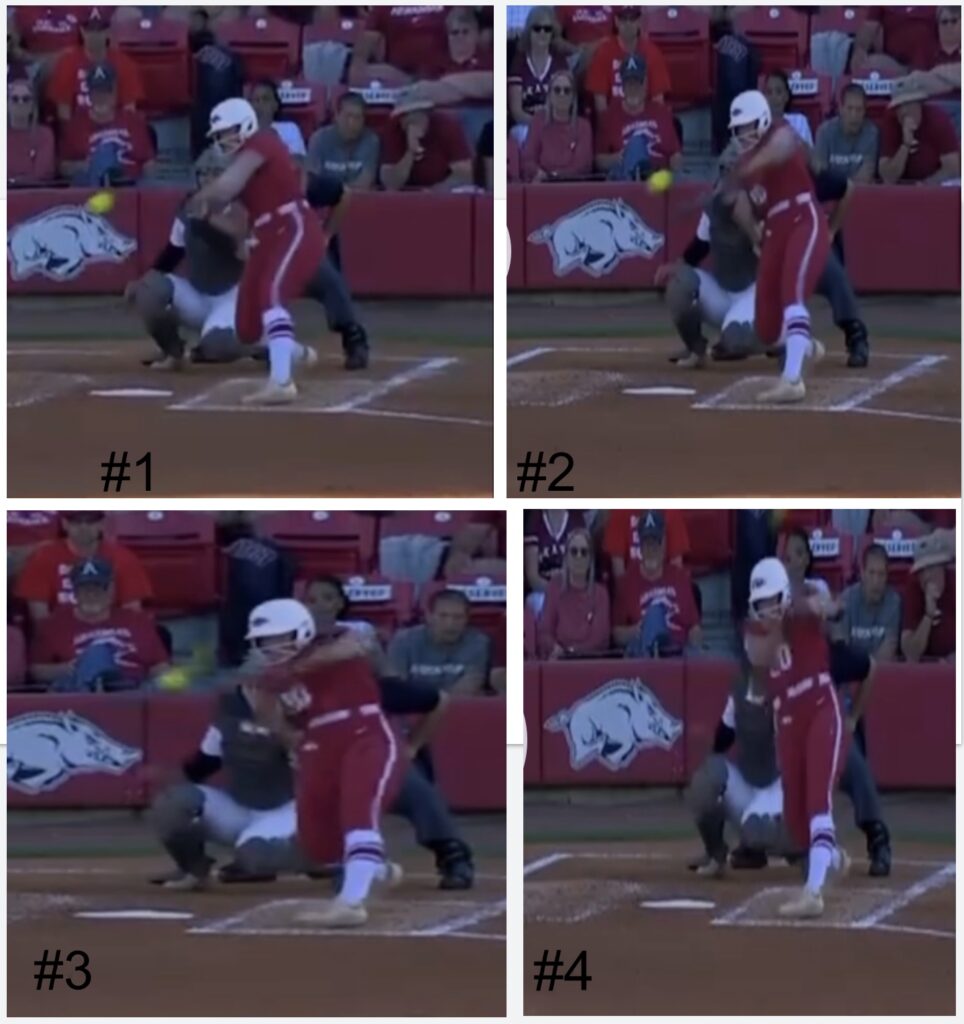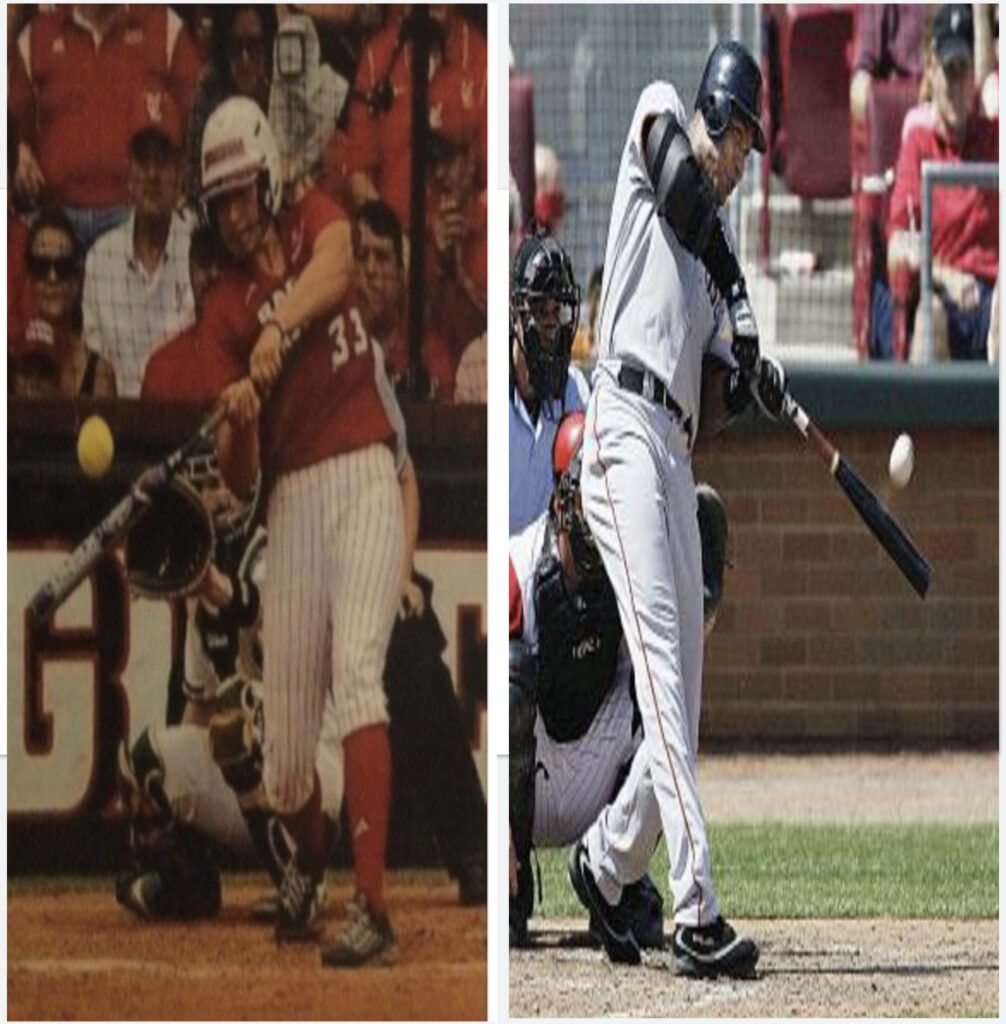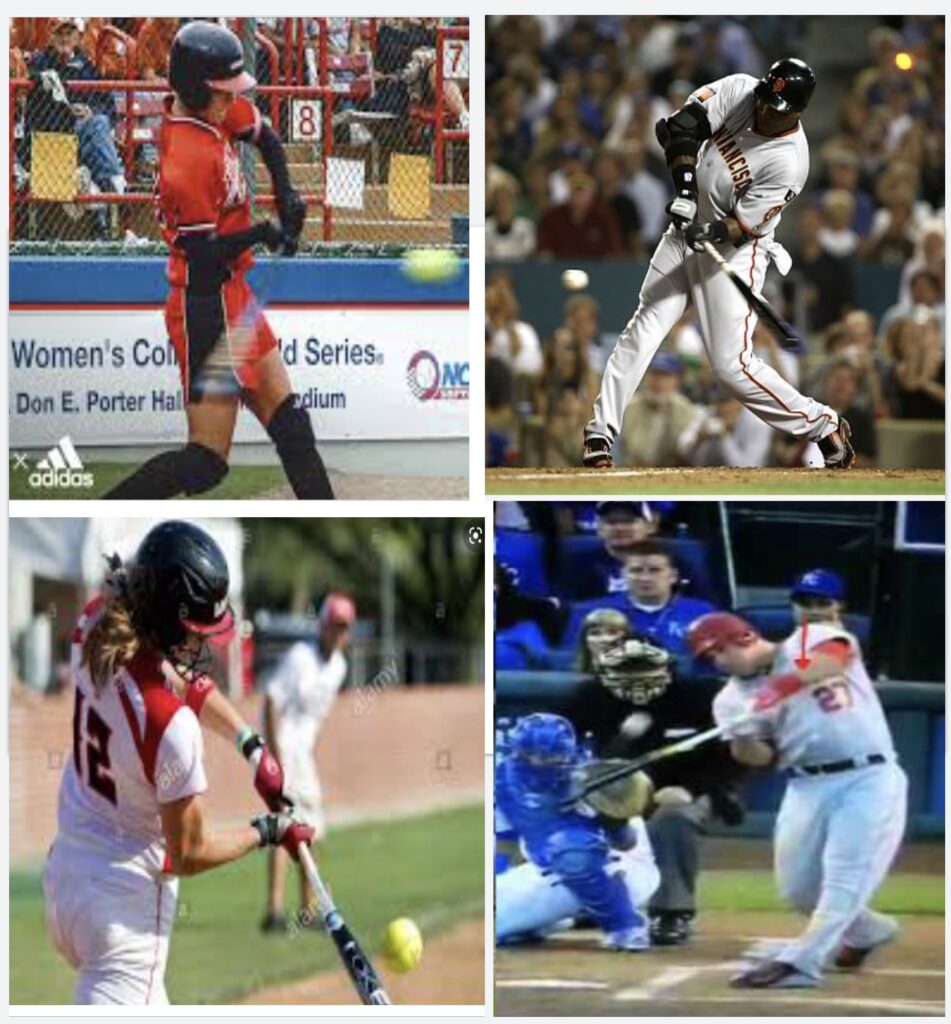
When watching Super Regionals (Texas vs Arkansas, game 2), there was a 21 pitch at bat – 15 foul balls. FIFTEEN! Mostly on inside pitches. On one of the pitches, the batter swung and missed — the ball actually hit her after she missed (hit her in her back shoulder). Finally, the at-bat ended with a weak line out to second base on a change-up. WATCH THE ENTIRE AT-BAT BELOW.
Biomechanically, the hitter’s goal should be to get the torso energized as much as possible by creating elasticity before swinging the center of mass of the bat as quickly as possible. The goal is to shorten and quicken the swing path as much as possible to minimize timing error.
Momentum transfer of biomechanics is such a nonintuitive concept – BUT it’s a topic that coaches and hitters have to be familiar with. Understanding GOOD MOMENTUM TRANSFER and the underlying principles of momentum transfer will help coaches and hitters avoid struggling “against” the underlying swing mechanics principles.
It is most important to point out that the transfer mechanics are different in hitting and overhand throwing/pitching. In both throwing and hitting, the body generates power from the turning torso in the same way. In pitching, this is used to whip the arm. In hitting, the hitter has a two handed grip on a long heavy object. The bat must be torqued to extension without allowing the hands to get away from the body’s center of rotation — otherwise, the chain of the momentum transfer will be broken.
Momentum is transferred from the hip to the shoulders by untwisting of the coiled torso/trunk that happens when the PELVIS ROTATES BEFORE THE SHOULDERS TILT. When the untwist is PROXIMAL TO DISTAL and proceeds up from the pelvis to the top of the spine, the back foot drags as an indication that momentum is being transferred UPWARD. The momentum transfer continues as the barrel is torqued out of the arc of the hand path. Lastly, the hands can extend away from the body’s axis of rotation only when the bat head is nearly fully extended.
One of the main problems many hitters have is they try to swing with ALL ARMS causing the hand path to extend away from the torso prematurely resulting in squishing the bug. This early extension with the arms does NOT HAVE THE ENERGY FROM THE PELVIS, & sometimes, the barrel path DIFFERS FROM THE PLANE OF THE TORSO TURN/UNTWIST.

This flawed, whipping hand path that causes pushing out early and extending with the top hand and sends the hands away from the torso early prevents any pelvis energy from getting through the torso to the bat. Instead, the hips just open to get out of the way so the torso can swing the bat directly. This causes a severe breakdown due the unstable, inconsistent, shifting axis of rotation that goes along with this whipping hand path/flawed push-top hand extended swing.
When the arms are allowed to extend prematurely in order to take the hands to the ball and bypass the pelvis, the result is:
- a long swing that gradually picks up speed instead of being ”instant”;
- long to the ball without any quickness, resulting in the hitter having to get started earlier;
- worse pitch recognition & getting fooled a lot and swinging at bad pitches because the hitter has to start earlier to be on time;
- having to make contact with inside pitches ”way out front” which can result in actually swinging and missing at a pitch in front of you and then the pitch actually hitting your body afterwards;
- a swing that does not match the plane of the pitch well;
- hard to keep the ball fair, especially the inside pitch;
- there is no significant momentum transfer from the pelvis – THE SHOULDERS TILT BEFORE PELVIS ROTATION. There is only the sign of momentum going from the torso to the bat without the torso having received momentum from the pelvis;
- the power does not get to the torso from the pelvis – the pelvis is bypassed by the shoulders, and the swing is LONG and only gradually picks up speed instead of being ”instant”;
- The bat goes out away from the torso – sweeping – and extends with early wrist roll, then pulls away and across the body;
- The hitter hits AROUND THE BALL and sometimes finishes with the dreaded hitting themselves on their back with the barrel during the follow through of the swing;
- This whipping, hand path swing results in WEAK STUFF TO THE OPPOSITE FIELD & BALLS HIT DEAD PULL SIDE & most times DEAD PULL SIDE FOUL, OVER AND OVER & not much in between.
The fix is KEEPING the hands in and letting the PELVIS GO FIRST. Let the energy build up and transfer efficiently upward and proximal to distal which will result in a rapidly accelerating bat that is quick to the ball with an angle of contact that can keep the ball fair. Only at or after contact, do the hands extend out of the hand path circle.

It’s a game of inches. Pay particular attention to the small details! Momentum transfer is a GAME CHANGER!

PURSUE EXCELLENCE & WIN THIS PITCH!
About the Author

Mike Lotief coached 17 successful years as either the head softball coach or co-head softball coach with his wife Stefni Whitton Lotief at the University of Louisiana from 2002-2017 with an overall coaching record of 731-176 (80.6 winning percentage). Every season, the Ragin Cajuns softball team advanced to the NCAA tournament and also advanced to three (3) Women’s College World Series (2003, 2008, 2014) and from 2012-2016 advanced to five (5) straight NCAA Super Regionals. Coach Lotief produced over 40 All American selections and his 2017 team lead the nation in scoring and was ranked in the Top 10 in home runs, slugging percentage, on base percentage.
The coach is a cancer survivor (twice) and was the first person in the U.S. to receive the Pro Trach device. Mike and Stefni spearheaded and raised the funding to build the new softball stadium in 2009 and the new softball indoor hitting facility in 2015. They are proud parents to Chelsea, who played softball and graduated from the Univ. of Louisiana in 2018, and Andrew, who is a junior at Louisiana studying Mechanical Engineering.
Previous Articles in this Series
- The Mental Swing Attractors: Failure Cannot Break You (Nov. 11, 2021)
- Training Insights: “Swing Attractors” by Coach Mike Lotief… the Flaws of Pelvic Loading (Nov. 9, 2021)
- The Mental Swing Attractors: Push Yourself… You Don’t Have to Be #1 to BE #1! (Nov. 4, 2021)
- Training Insights: “Swing Attractors” by Coach Mike Lotief… Pelvis Loading, Part 2—The Planes of Movement (Nov. 2, 2021)
- The Mental Swing Attractors: Remove the Rope from Your Ankle & Get Rid of the Limiting Beliefs! (Oct. 28, 2021)
- Training Insights: “Swing Attractors” by Coach Mike Lotief… Pelvis Loading, Part 1—It’s All in the Hips (or Somewhere Deep Below) Oct. 26, 2021
- The Mental Swing Attractors: Champions are Developed by Devotion & Discipline! (Oct. 21, 2021)
- Training Expertise: “Swing Attractors”… the Secrets of Power Hitting by Coach Mike Lotief (Oct. 19, 2021)
More About Mike Lotief
- Why Michael Lotief is a Legendary Coach? by Jay Patel
- The Secret To Michael Lotief’s Success. By Jay Patel
- Michael Lotief Fights for Rajin’ Cajuns by Graham Hays ESPN
- Michael Lotief: Taking His Sport to New Heights by Neha Kapoor
- For the Love of the Game: A Look at Ragin’ Cajun Softball’s Power Couple
- How Louisiana-Lafayette’s Michael Lotief Develops Hitting Gems by Graham Hays ESPN
